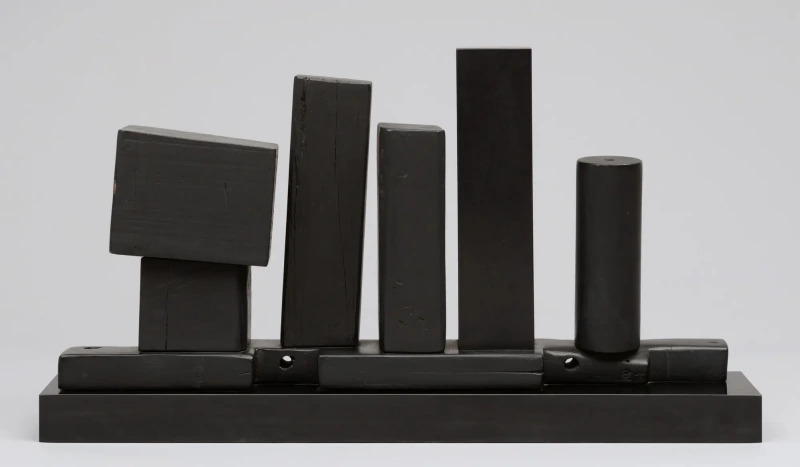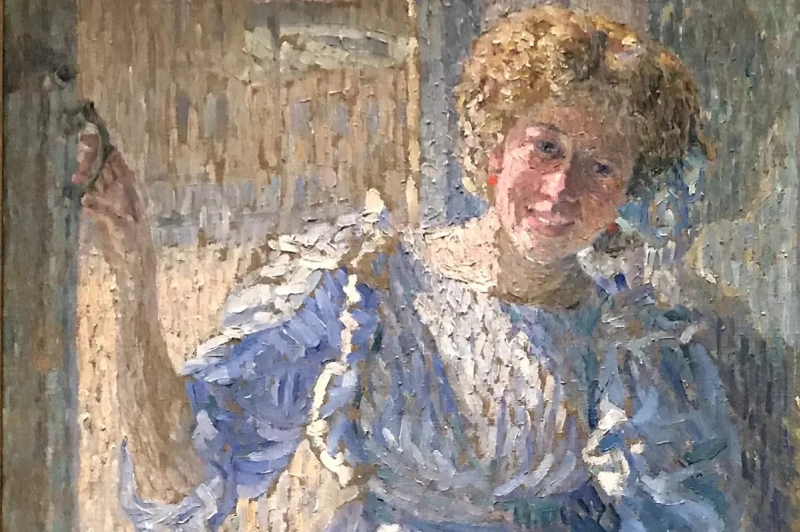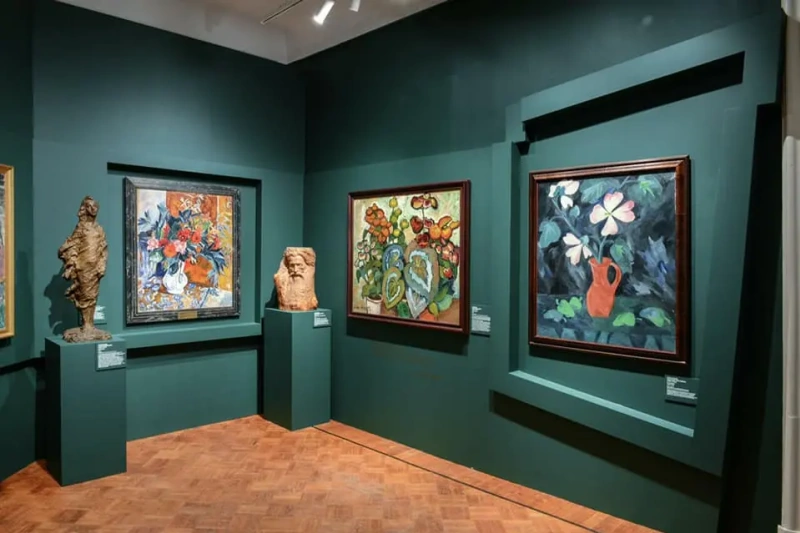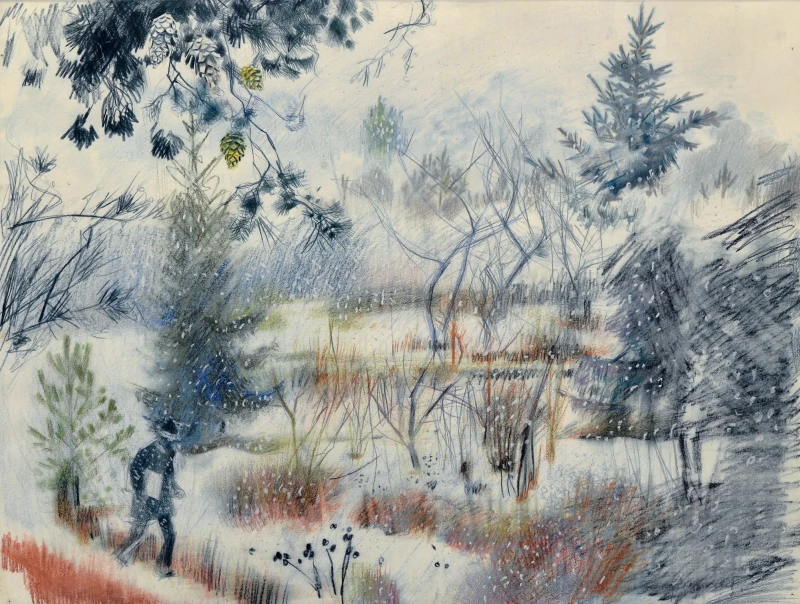log in
Enter site
Login to use Arthive functionality to the maximum
"Father of Russian Futurism", biting in his statements and sharp in manifestos, David Burliuk in life was a man calm, unpretentious and with a heightened fatherly instinct in relation to "throwing the classics from the ship of modernity." Moreover, a man who managed not to quarrel with his fellow futurists around him - and as a rule, they, as a rule, did not differ by a gentle disposition. At the same time, his surname was common, and Alexander Blok even complained: “Burliuks, whom I haven’t seen yet, scare me away. I am afraid that there is more rudeness here than anything else ... ”
David Burliuk was born in the family of an agronomist in the Kharkov province. He had two brothers and three sisters. All of them did not shy away from brushes, and Nikolay was also quite good as a poet. By the way, it was Nikolai who “presented”, if it is appropriate to say so, a distinctive external feature to David. In childhood, during a fight, Nikolai knocked out his brother's eyes. Subsequently, the glass eye and lornet became the trademark of David Burliuk. He praised them and even declared that his particular artistic view was connected with the fact that he was looking at the world with one eye.
David studied at art schools in Kazan and Odessa, tried to enter the Academy of Arts, but failed the exam. I had to “be content” with Munich (Royal Academy of Arts) and Paris (School of Fine Arts of Cormon).
He was an excellent organizer and the leader, he was able not only to rally all those interested in himself, but also held exhibitions, composed manifestos and personally fostered several luminaries. Mayakovsky said that it was Burliuk who made him a poet - he gave him 50 kopeks every day so that he would not have to write hand to hand. And it's not about the metaphor.
Upon returning after studying to Russia, Burliuk was in the thick of the literary and artistic avant-garde. In the 1910s, the poets of Mayakovsky, Kamensky and Khlebnikov, artists Larionov and Lentulov and many others. David Burliuk wrote the famous futurist manifesto with a telling title: "A slap in the face of public taste"where called upon "Reset the classics from the ship of modernity".
Burliuk was one of the organizers of the artistic of the company "Jack of Diamonds"which denied academicism and realism, but post-impressionism, Fauvism and Cubism were treated warmly. Subsequently, “The Jack of Diamonds” split into two currents: some of the artists separated and chose a new French painting as a guide (Robert Falk, Pyotr Konchalovsky), and Burliuk, Malevich, Goncharova and Larionov were guided by the national color, folk art and splint. They called their movement quite outrageous - “Donkey's Tail”.
David Burliuk was noted, it seems, in all the many artistic directions of that troubled time. Researchers from this period love to talk round the line that “David Burliuk’s work is very eclectic.” In the 1910s, he "flirted" with primitivism. Echoes of Chagall, who abolished the laws of gravity and sent his heroes to flight, can be seen in "Headless Barber". However, in this picture the similarity is purely technical, the magic of Chagall did not pass to the canvas of David Burliuk. It is understandable - he wrote "The Hairdresser" while working on "The slap in the face of public taste," and reflected in it the "three whales" of futurism: disharmony, asymmetry and disstructuring. Where is Chagall, and where is disharmony? But still to the right from the window, it seems, looks “a little Chagall.” Feeling here and echo of "Hairdressers" by Mikhail Larionov (1, 2, 3).
And, for example, in Harvest and “You will rub the futurist Vasily Kamensky’s songwriter” Burliuk became more convincing. Here it is already felt that the space of the picture lives by its own laws, and not just breaks the habitual ones.
Often he turned to post-impressionistic motifs, especially in naturmorta. Well, isn't it obvious that here "Van Gogh spirit, Van Gogh smells like"? Later, having emigrated to the United States, Burliuk proclaimed himself the "American Van Gogh".
Landscapes Burliuk generally performed quite realistic. Their peculiarity is that he often used a very thick colorful texture, so that the whole “growths” appeared on the canvas, such as "Landscape with the road".
How bitter and merciless Burliuk is in his accusatory manifestos! As zealously calls to consign to everything that seems yesterday. He convicts and convicts, the gleam of his lornet is always on the front line. It seems that such a person in life should be harsh, indefatigable, irreconcilable. What do contemporaries say about this?
David Burliuk in every possible way rushed with Khlebnikov, cared for Mayakovsky, who until the end of his life called him his teacher, completely shook the 25-year-old poet Benedict Livshits, inviting him to Chernyanka with the words: "Dear child, we are going with me!".
The “Father of Russian Futurism” indeed manifested paternal feelings for his colleagues. Here it is appropriate to recall the less well-known expression from the “Manifesto” than the dismissed Pushkin and Tolstoy, but, perhaps, revealing the riddle of David Burliuk’s personality: "Who does not forget the first love, he will not know the last love"... Maybe it was precisely due to the impudent lack of piety towards the authorities of the past that he was filled with tenderness and solicitude towards the current - ragged, awkward, prickly future heroes? There is a legend that Ilya Repin wanted to paint a portrait of Velimir Khlebnikov, but was refused. Khlebnikov said that Burliuk had already written it, and it is simply impossible to better, since "Only there I look like a triangle."
Later, Aristarkh Lentulov would be disappointed with the meeting with Burliuk, for he expected to see a demon with a lorgnet, a subverter of values, and before him appeared "Medium businessman retired". Lentulov remembers that "By nature Burliuk was a family man-man in the street, not seeking luxury".
During the civil war, Burliuk finds himself in Bashkiria, and then wanders through Siberia and the Far East, promoting futurism. By the time he is already married. Maria Burliuk (nee Yelenevskaya) emigrated with her husband to Japan in 1920 (there is a version that her father was an influential person in Vladivostok and helped with emigration). In Japan, David Burliuk wrote about ten landscapes: "Mount Fuji, Japan", "Temple Gate in Japan".
Some researchers believe that the Japanese period was for Burliuk only a way to earn money for emigration to the United States, and he wrote for the public. Japanese art critics strongly disagree with this approach. Moreover, Burliuk did not forget about futurism in Japan: "On the beach"... The Land of the Rising Sun generally considers David Burliuk to be the founder of Japanese futurism (and here he is a father!).
In 1922, Burliuk moved to the United States and opened a publishing house that published prose, poetry, journalism and memoirs. He successfully assimilated in America. He writes a lot, is recognized, his works are exhibited in the best museums and galleries, he travels a lot in Europe. In 1950, he even opened his own gallery on Long Island.
David Burliuk compared the artwork with a battery that needs to be recharged. Judging by his life, he himself turned out to be an excellent “piece of art”. And his charge was enough to fully manifested itself many artists and poets of new art. And Burliuk himself, we do not forget, managed to “give birth” to both Russian and Japanese futurism.
Author: Alain Esaulova
Read more
David Burliuk was born in the family of an agronomist in the Kharkov province. He had two brothers and three sisters. All of them did not shy away from brushes, and Nikolay was also quite good as a poet. By the way, it was Nikolai who “presented”, if it is appropriate to say so, a distinctive external feature to David. In childhood, during a fight, Nikolai knocked out his brother's eyes. Subsequently, the glass eye and lornet became the trademark of David Burliuk. He praised them and even declared that his particular artistic view was connected with the fact that he was looking at the world with one eye.
David studied at art schools in Kazan and Odessa, tried to enter the Academy of Arts, but failed the exam. I had to “be content” with Munich (Royal Academy of Arts) and Paris (School of Fine Arts of Cormon).
He was an excellent organizer and the leader, he was able not only to rally all those interested in himself, but also held exhibitions, composed manifestos and personally fostered several luminaries. Mayakovsky said that it was Burliuk who made him a poet - he gave him 50 kopeks every day so that he would not have to write hand to hand. And it's not about the metaphor.
Upon returning after studying to Russia, Burliuk was in the thick of the literary and artistic avant-garde. In the 1910s, the poets of Mayakovsky, Kamensky and Khlebnikov, artists Larionov and Lentulov and many others. David Burliuk wrote the famous futurist manifesto with a telling title: "A slap in the face of public taste"where called upon "Reset the classics from the ship of modernity".
Burliuk was one of the organizers of the artistic of the company "Jack of Diamonds"which denied academicism and realism, but post-impressionism, Fauvism and Cubism were treated warmly. Subsequently, “The Jack of Diamonds” split into two currents: some of the artists separated and chose a new French painting as a guide (Robert Falk, Pyotr Konchalovsky), and Burliuk, Malevich, Goncharova and Larionov were guided by the national color, folk art and splint. They called their movement quite outrageous - “Donkey's Tail”.
David Burliuk was noted, it seems, in all the many artistic directions of that troubled time. Researchers from this period love to talk round the line that “David Burliuk’s work is very eclectic.” In the 1910s, he "flirted" with primitivism. Echoes of Chagall, who abolished the laws of gravity and sent his heroes to flight, can be seen in "Headless Barber". However, in this picture the similarity is purely technical, the magic of Chagall did not pass to the canvas of David Burliuk. It is understandable - he wrote "The Hairdresser" while working on "The slap in the face of public taste," and reflected in it the "three whales" of futurism: disharmony, asymmetry and disstructuring. Where is Chagall, and where is disharmony? But still to the right from the window, it seems, looks “a little Chagall.” Feeling here and echo of "Hairdressers" by Mikhail Larionov (1, 2, 3).
And, for example, in Harvest and “You will rub the futurist Vasily Kamensky’s songwriter” Burliuk became more convincing. Here it is already felt that the space of the picture lives by its own laws, and not just breaks the habitual ones.
Often he turned to post-impressionistic motifs, especially in naturmorta. Well, isn't it obvious that here "Van Gogh spirit, Van Gogh smells like"? Later, having emigrated to the United States, Burliuk proclaimed himself the "American Van Gogh".
Landscapes Burliuk generally performed quite realistic. Their peculiarity is that he often used a very thick colorful texture, so that the whole “growths” appeared on the canvas, such as "Landscape with the road".
How bitter and merciless Burliuk is in his accusatory manifestos! As zealously calls to consign to everything that seems yesterday. He convicts and convicts, the gleam of his lornet is always on the front line. It seems that such a person in life should be harsh, indefatigable, irreconcilable. What do contemporaries say about this?
David Burliuk in every possible way rushed with Khlebnikov, cared for Mayakovsky, who until the end of his life called him his teacher, completely shook the 25-year-old poet Benedict Livshits, inviting him to Chernyanka with the words: "Dear child, we are going with me!".
The “Father of Russian Futurism” indeed manifested paternal feelings for his colleagues. Here it is appropriate to recall the less well-known expression from the “Manifesto” than the dismissed Pushkin and Tolstoy, but, perhaps, revealing the riddle of David Burliuk’s personality: "Who does not forget the first love, he will not know the last love"... Maybe it was precisely due to the impudent lack of piety towards the authorities of the past that he was filled with tenderness and solicitude towards the current - ragged, awkward, prickly future heroes? There is a legend that Ilya Repin wanted to paint a portrait of Velimir Khlebnikov, but was refused. Khlebnikov said that Burliuk had already written it, and it is simply impossible to better, since "Only there I look like a triangle."
Later, Aristarkh Lentulov would be disappointed with the meeting with Burliuk, for he expected to see a demon with a lorgnet, a subverter of values, and before him appeared "Medium businessman retired". Lentulov remembers that "By nature Burliuk was a family man-man in the street, not seeking luxury".
During the civil war, Burliuk finds himself in Bashkiria, and then wanders through Siberia and the Far East, promoting futurism. By the time he is already married. Maria Burliuk (nee Yelenevskaya) emigrated with her husband to Japan in 1920 (there is a version that her father was an influential person in Vladivostok and helped with emigration). In Japan, David Burliuk wrote about ten landscapes: "Mount Fuji, Japan", "Temple Gate in Japan".
Some researchers believe that the Japanese period was for Burliuk only a way to earn money for emigration to the United States, and he wrote for the public. Japanese art critics strongly disagree with this approach. Moreover, Burliuk did not forget about futurism in Japan: "On the beach"... The Land of the Rising Sun generally considers David Burliuk to be the founder of Japanese futurism (and here he is a father!).
In 1922, Burliuk moved to the United States and opened a publishing house that published prose, poetry, journalism and memoirs. He successfully assimilated in America. He writes a lot, is recognized, his works are exhibited in the best museums and galleries, he travels a lot in Europe. In 1950, he even opened his own gallery on Long Island.
David Burliuk compared the artwork with a battery that needs to be recharged. Judging by his life, he himself turned out to be an excellent “piece of art”. And his charge was enough to fully manifested itself many artists and poets of new art. And Burliuk himself, we do not forget, managed to “give birth” to both Russian and Japanese futurism.
Author: Alain Esaulova
-
Artworks liked by180 users
- Artworks in 9 collections and 247 selections
Publication
Exhibitions
All exhibitions of the artist
Sleigh rides
1966, 20.5×25.5 cm

Flowers in the window
1962, 127×99 cm

Live lobster at Joe's
1961, 61×50 cm

Portrait of a young woman
1960, 18×13.3 cm

Still life on the coast
1958, 76×60 cm

A house on the ocean
1958, 40×50 cm

Mother and child
1957

The woman at the lake
1957, 20×25 cm

Peasant lunch
1956, 11×14 cm
Feed
Solidarity. Works of ethnic Ukrainiansexhibition added




















